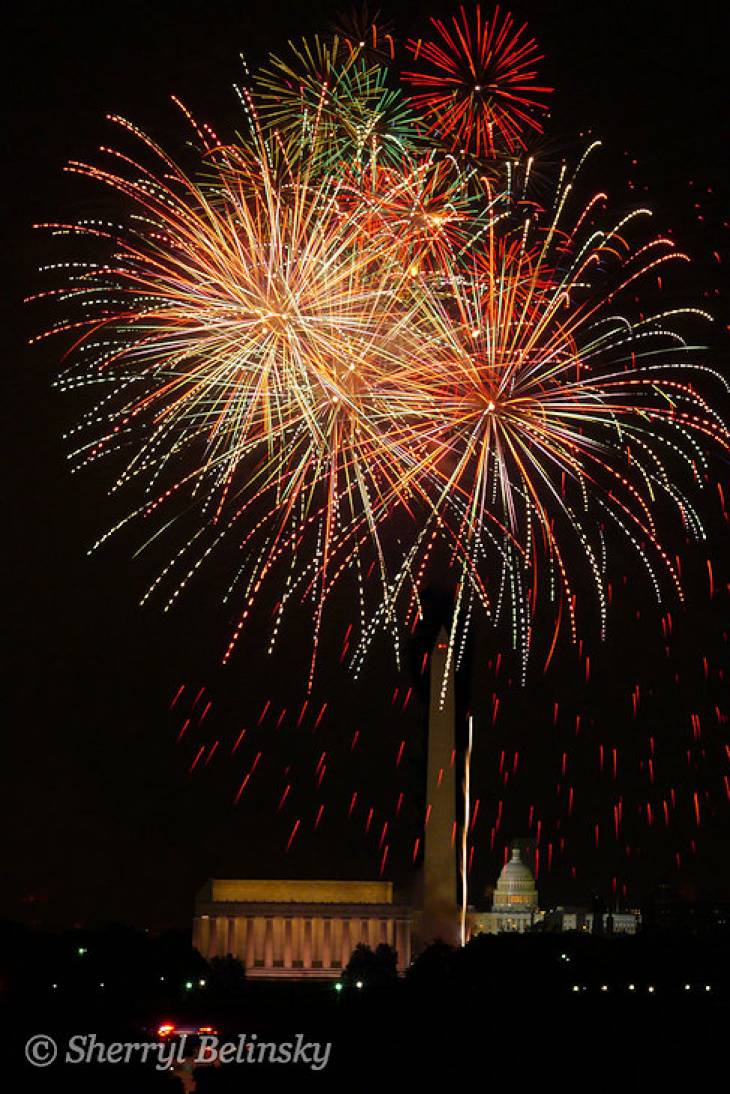It’s time for Fireworks!

There is no place better to photograph fireworks than Washington, DC on Independence Day…with a multitude of venues in and around the city that provide plenty of photographic opportunities.
As Independence Day approaches, here is a list of sites with the best views of those incomparable fireworks over the Nation’s Capital: https://washington.org/visit-dc/top-spots-catch-fireworks-washington-dc
Tips for Photographing fireworks:
These tips will allow you to to capture just the right amount of fireworks for the effect you desire.
- First, you will need a tripod. The long exposures – anywhere from 2 to 10 seconds or more – needed to capture the fireworks trails will cannot be achieved unless your camera is on a tripod. Something else that can blur your photos is pressing the shutter release button, so a remote release – a cable, wireless remote or smartphone is also necessary.
- Next, you’ll want a lens or two that give you a variety of framing options. Depending on where you set up and what obstructions are in your path, a zoom lens will allow you to get your composition just right. It will also afford you variety with respect to story-telling: a telephoto focal length allows you to compress elements with the fireworks, while a wide-angle field of view will allow you to include different context in your framing, such as the viewers in the foregraound.
- Use the lowest ISO possible (usually ISO 100), which will minimize noise and maximize dynamic range. Raising the ISO simply brightens tones so much as to often blow the fireworks to white. If you wish to raise dark tones, like the skies and cityscape, it’s better to selectively brighten them in post-processing, rather than increase the ISO which raises the exposure of all tones in your image.
- Shoot Raw. This affords you the most post-processing flexibility with respect to exposure of tones, and colors of various tones, including white balance adjustment. The fireworks are bright, so you don’t want to overexpose them and blow out the highlights, while the rest of the city and sky are dark, which you don’t want to underexpose. Larger sensor cameras, with higher dynamic range, allow you maximum flexibility in post-processing, if you shoot Raw. This allows you to recover colors in the bright fireworks, brighten dark blue tones in the sky, and to set White Balance perfectly to balance the warm colors of the fireworks and the blue colors of the sky.
- Set an F-Stop of F8 for enough depth-of-field, and to ensure that the initial launch of the fireworks itself doesn’t register too brightly in your final photograph.
- Set your Drive mode to Manual/Bulb. (Make sure to test the remote before-hand, so that you are familiar with its operation,) Trigger the shutter with your remote when no action is occurring, to allow the camera to start accumulate background exposure to capture some of the sky blue and city lights. Once the fireworks explode, continue to capture some of the trails, then end the exposure with your remote. That will allow you to capture enough of the fireworks to get a pattern against a well exposed deep blue sky. Any other exposure adjustments to balance the sky, foreground, and fireworks can be saved for post-processing of the Raw file. You can also use a piece of cardboard to cover the lens and then remove it to capture multiple bursts of fireworks.
Now that you’ve got a handle on the basic principles, here are a few easy tricks you can try:
- Move away from the show – There’s a natural tendency to want to get close to, or directly underneath, a fireworks show. This works well if your goal is to capture closeups of the fireworks, but without other visual cues, fireworks over DC look the same as fireworks over London. Try moving away from the show and using a telephoto lens to frame fireworks against a city skyline or landscape to provide some context to your photos and to provide a sense of place. For instance, the Netherlands Carillon provides the iconic view of DC.
- Move away from the show and add the human element – take a step back and frame the human element, with the fireworks in the background. Here the people are an integral part of the framing, so use a small aperture increased depth-of-field to get both the viewers and the fireworks in focus. You can also get closer to the viewers to create more separation between them and the fireworks, and use a fast aperture to throw the viewers or the fireworks out-of-focus for a creative effect.
- Try adjusting the zoom – Zoom in or out by slowly and evenly twisting the barrel of the lens to create an abstract look.
Make sure to send your best photos to WPS, and we will post them on our Facebook page…Happy Independence Day!
